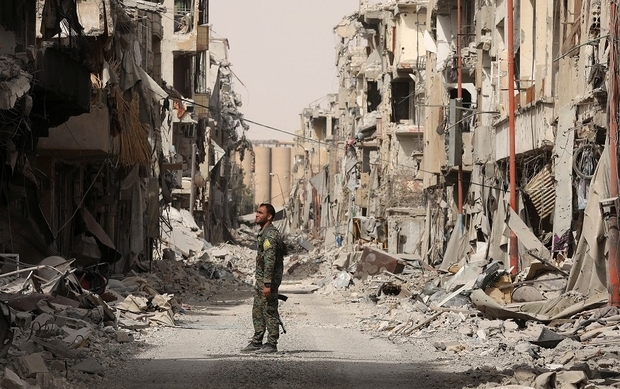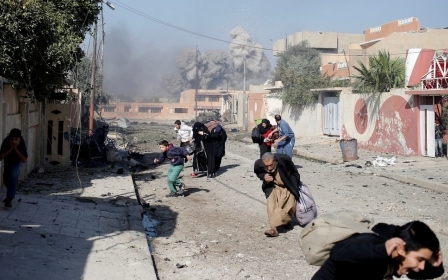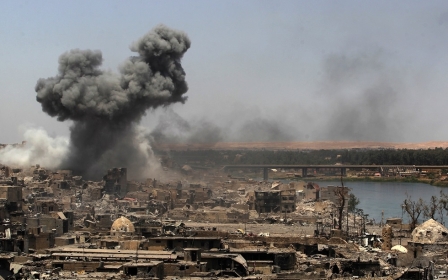Syria and Iraq air campaigns behind huge rise in civilian deaths

LONDON - More than 15,000 civilians were killed by explosive weapons in 2017 with air strikes in Syria, Iraq and Yemen accounting for a majority of the deaths, a new UK parliamentary inquiry into explosive threats has heard.
The global civilian death toll from explosive weapons, including air-dropped bombs and missiles as well as improvised explosive devices, soared by 42 percent last year, the All-Party Parliamentary Group (APPG) on Explosive Threats, was told on Wednesday.
The new figures, from a forthcoming Action on Armed Violence report, were announced as MPs in London opened a major inquiry into the experience of victims of explosive violence, the results of which will be announced this summer. It is expected to focus on a rise in deaths from air strikes in Iraq, Syria and Yemen.
'Truly depressing statistics'
The dramatic rise in deaths last year coincided with increased Russian air strikes in Syria, alongside US-led operations to reclaim the Islamic State (IS) group strongholds of Mosul, in Iraq, and Raqqa, in Syria. The increased death toll also coincided with ongoing Saudi-led bombardment in Yemen.
MPs said the figures were “alarming” and campaigners raised questions over the role played by the US Air Force and the UK's Royal Air Force in air strikes on Iraq and Syria, including over the transparency of the legal criteria used by the British military to determine whether an individual is an IS militant.
Matthew Offord, a Conservative MP and chairman of the APPG, said: “These are truly depressing statistics. The needless pain and suffering caused by the futile use of explosive weapons is something the perpetrators should be thoroughly ashamed of.”
In an interview with Middle East Eye, Offord added that the inquiry would call for evidence from the Ministry of Defence (MoD) and would report back its findings to ministers, a move welcomed by campaigners.
The US military has said it has unintentionally killed at least 801 civilians in Iraq and Syria. However, to the consternation of campaigners, the MoD in London has repeatedly said it has “not seen any evidence” that Royal Air Force (RAF) jets or drones have caused civilian casualties.
Iain Overton, executive director at Action on Armed Violence, which produced the figures and will be providing evidence to the inquiry, told MPs that the MoD claim was “challenging” and “runs against common reason”.
He said: “As governments have less appetite to put boots on the ground they have replaced that with air strikes, and that has resulted in a sharp uptick in the numbers of civilians killed.”
Overton's comments come after a former Royal Air Force deputy commander branded as "almost unbelievable" the British government's claims that no credible evidence exists to suggest civilians were killed in the years-long campaign against IS.
Speaking in January, Greg Bagwell, who as an air marshall oversaw air strikes in Iraq, Syria and Libya before retiring in 2016, said: "I don't think it's credible… that we have not caused any civilian casualties.”
'Inhuman behaviour'
An MoD spokesperson told MEE: “Given the ruthless and inhuman behaviour of our adversary, including the deliberate use of human shields, we must accept that the risk of inadvertent civilian casualties is ever present, particularly in the complex and congested urban environment within which we operate.”
The spokesperson added: “We do everything we can to minimise the risk to human life from UK strikes through our rigorous targeting processes and the professionalism of the RAF crews. While we’ve not seen any evidence that we have caused civilian casualties, that isn’t the same as saying we have not or will not do so, especially in close urban fighting against a ruthless terrorist enemy that uses civilians as human shields.”
The new inquiry from the APPG, which will accept evidence on US coalition, Saudi Arabian and Russian air strikes, comes after MEE revealed in October that the RAF had dropped more than 3,400 bombs and missiles on IS in Iraq and Syria since 2014.
The RAF says it takes all steps to minimise civilian casualties, but the vast quantity of ordnance dropped since the start of Operation Shader against IS in 2014 seriously undermines the claim by ministers that the RAF has not caused any civilian casualties in the three-year-long bombing campaign.
Reacting to the figures, military aviation experts and campaigners said that it is no longer credible for the MoD to maintain that it has not killed any civilians.The role of RAF jets and drones in the region is coming into focus this month as the US-led coalition announced a “shift in focus” to Syria following the defeat of a large number of IS fighters in Iraq, while the use of suicide vehicles is expected to make targeting more difficult for coalition jets.
In November, Air Commodore Johnny Stringer, who led the British air campaign against the militant group until the middle of last year, had suggested that the RAF’s air war against IS was set to be reduced starting in March, with the return home of some of the eight Tornado GR4 fighter bombers and six Eurofighter Typhoon fast jets deployed to the region.
However, a Ministry of Defence source on Tuesday played down speculation that jets would soon be returning to their home bases.
“No timescales for any form of drawdown have been set, asset drawdown will only be started when the job is done,” the MoD source told MEE.
New MEE newsletter: Jerusalem Dispatch
Sign up to get the latest insights and analysis on Israel-Palestine, alongside Turkey Unpacked and other MEE newsletters
Middle East Eye delivers independent and unrivalled coverage and analysis of the Middle East, North Africa and beyond. To learn more about republishing this content and the associated fees, please fill out this form. More about MEE can be found here.





